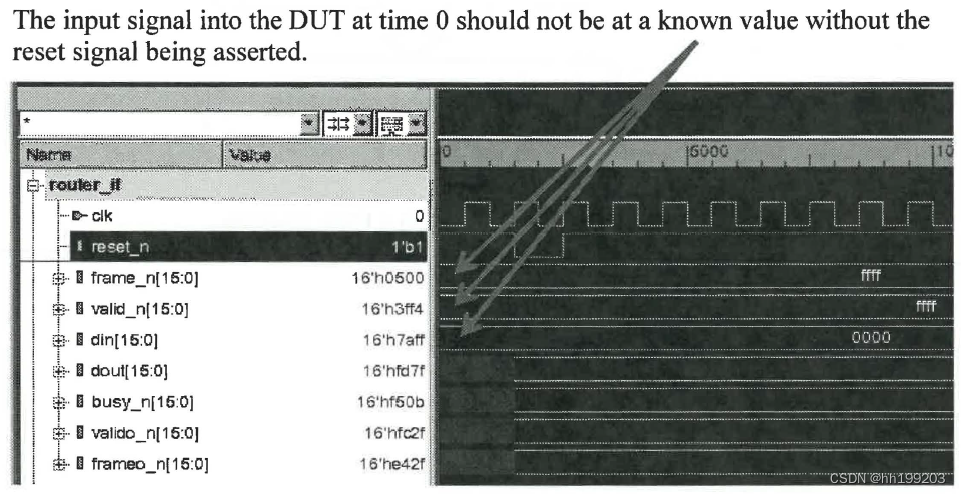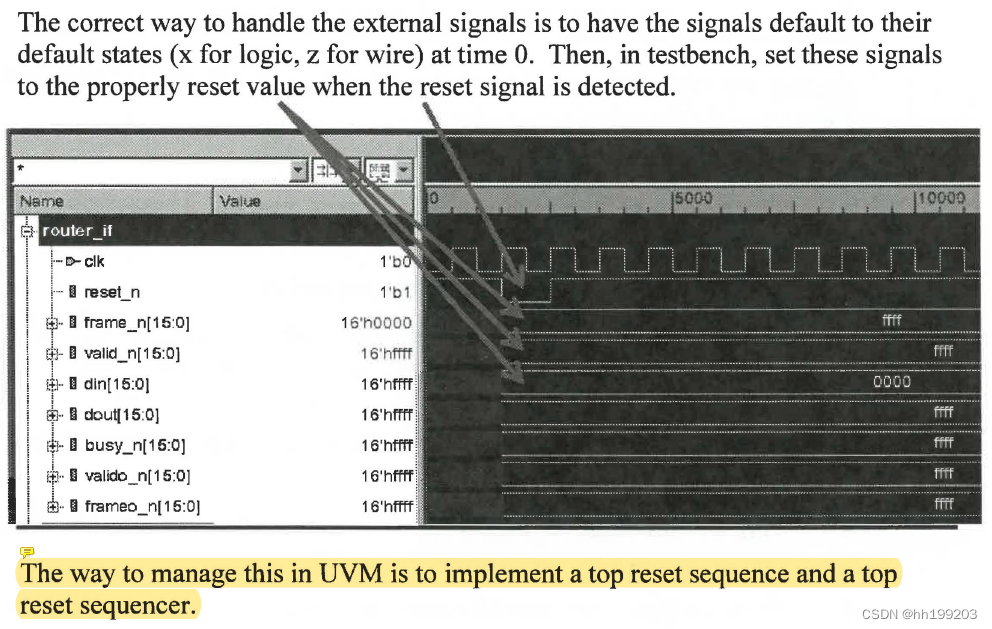UVM环境中reset复位的处理
文章目录
- 前言
- 一、单独处理reset复位信号
- 1.1 复位agent的实现
- 1.2 复位transaction和interface
- 1.3 environment
- 1.4 复位sequence
- 1.5 Top_env_test
- 1.6 Top_env_tb
- 1.7 Top_env_top
- 1.8 小结
- 二、处理其他驱动接口的复位值
- 2.1 顶层管理复位的sqr和seq
- 2.2 base_test
- 2.3 host_reset_sequence
- 2.4 小结
- 总结
前言
复位存在于每一个验证环境中,简单的同时,也是我们最容易忽略的功能点。在验证环境中,通常复位信号的处理,就是在top顶层产生时钟时,做一个复位的动作。这样做的好处是简单,但是如果我们想在仿真过程中,加入一个复位的动作,实现起来就比较麻烦,对于接口上,复位后驱动的复位值,也难以实现。
本文主要介绍一种通用的方法,专门用来处理复位,具备很好的移植性,复用性,使用起来也非常方便,将复位相关的内容,单独拿出来处理,能够解决常规验证环境中,无法中间加入复位动作的痛点。
本文的思路是,先将复位信号单独拿出来进行处理,再介绍如何处理其他驱动接口上的复位值。
一、单独处理reset复位信号
单独处理reset复位信号的思路是,为复位信号单独建立一个agent,再建立复位信号的sequence,通过将复位信号的sequence,送入复位agent下sequencer中的reset_phase,其他驱动接口的sequence送入main_phase,从而实现系统仿真前的复位。
1.1 复位agent的实现
复位agent中包括driver、monitor、sequencer。这部分代码可以直接复用。
reset_agent.sv
typedef class reset_driver;
typedef class reset_monitor;
class reset_agent extends uvm_agent;
typedef uvm_sequencer#(reset_tr) reset_sequencer;
virtual reset_io vif; // DUT virtual interface
reset_sequencer sqr;
reset_driver drv;
reset_monitor mon;
`uvm_component_utils(reset_agent)
function new(string name, uvm_component parent);
super.new(name, parent);
`uvm_info("TRACE", $sformatf("%m"), UVM_HIGH);
endfunction: new
virtual function void build_phase(uvm_phase phase);
super.build_phase(phase);
`uvm_info("TRACE", $sformatf("%m"), UVM_HIGH);
`uvm_info("RSTCFG", $sformatf("Reset agent %s setting for is_active is: %p", this.get_name(), is_active), UVM_MEDIUM);
uvm_config_db#(virtual reset_io)::get(this, "", "reset_if", vif);
uvm_config_db#(virtual reset_io)::set(this, "*", "vif", vif);
if (is_active == UVM_ACTIVE) begin
sqr = reset_sequencer::type_id::create("sqr", this);
drv = reset_driver::type_id::create("drv", this);
end
mon = reset_monitor::type_id::create("mon", this);
endfunction: build_phase
virtual function void connect_phase(uvm_phase phase);
super.connect_phase(phase);
`uvm_info("TRACE", $sformatf("%m"), UVM_HIGH);
if (is_active == UVM_ACTIVE) begin
drv.seq_item_port.connect(sqr.seq_item_export);
end
endfunction: connect_phase
virtual function void end_of_elaboration_phase(uvm_phase phase);
super.end_of_elaboration_phase(phase);
`uvm_info("TRACE", $sformatf("%m"), UVM_HIGH);
if (vif == null) begin
`uvm_fatal("CFGERR", "Interface for reset agent not set");
end
endfunction: end_of_elaboration_phase
endclass
/*
class reset_tr extends uvm_sequence_item;
typedef enum {ASSERT, DEASSERT} kind_e;
rand kind_e kind;
rand int unsigned cycles = 1;
`uvm_object_utils_begin(reset_tr)
`uvm_field_enum(kind_e, kind, UVM_ALL_ON)
`uvm_field_int(cycles, UVM_ALL_ON)
`uvm_object_utils_end
function new(string name = "reset_tr");
super.new(name);
`uvm_info("TRACE", $sformatf("%m"), UVM_HIGH);
endfunction: new
endclass
*/
class reset_driver extends uvm_driver #(reset_tr);
virtual reset_io vif; // DUT virtual interface
`uvm_component_utils(reset_driver)
function new(string name, uvm_component parent);
super.new(name, parent);
`uvm_info("TRACE", $sformatf("%m"), UVM_HIGH);
endfunction: new
virtual function void build_phase(uvm_phase phase);
super.build_phase(phase);
`uvm_info("TRACE", $sformatf("%m"), UVM_HIGH);
uvm_config_db#(virtual reset_io)::get(this, "", "vif", vif);
endfunction: build_phase
virtual function void end_of_elaboration_phase(uvm_phase phase);
super.end_of_elaboration_phase(phase);
`uvm_info("TRACE", $sformatf("%m"), UVM_HIGH);
if (vif == null) begin
`uvm_fatal("CFGERR", "Interface for reset driver not set");
end
endfunction: end_of_elaboration_phase
virtual task run_phase(uvm_phase phase);
`uvm_info("TRACE", $sformatf("%m"), UVM_HIGH);
forever begin
seq_item_port.get_next_item(req);
drive(req);
seq_item_port.item_done();
end
endtask: run_phase
virtual task drive(reset_tr tr);
`uvm_info("TRACE", $sformatf("%m"), UVM_HIGH);
if (tr.kind == reset_tr::ASSERT) begin
vif.reset_n = 1'b0;
repeat(tr.cycles) @(vif.mst);
end else begin
vif.reset_n <= '1;
repeat(tr.cycles) @(vif.mst);
end
endtask: drive
endclass
class reset_monitor extends uvm_monitor;
virtual reset_io vif; // DUT virtual interface
uvm_analysis_port #(reset_tr) analysis_port;
uvm_event reset_event = uvm_event_pool::get_global("reset");
`uvm_component_utils(reset_monitor)
function new(string name, uvm_component parent);
super.new(name, parent);
`uvm_info("TRACE", $sformatf("%m"), UVM_HIGH);
endfunction: new
virtual function void build_phase(uvm_phase phase);
super.build_phase(phase);
`uvm_info("TRACE", $sformatf("%m"), UVM_HIGH);
uvm_config_db#(virtual reset_io)::get(this, "", "vif", vif);
analysis_port = new("analysis_port", this);
endfunction: build_phase
virtual function void end_of_elaboration_phase(uvm_phase phase);
super.end_of_elaboration_phase(phase);
`uvm_info("TRACE", $sformatf("%m"), UVM_HIGH);
if (vif == null) begin
`uvm_fatal("CFGERR", "Interface for reset monitor not set");
end
endfunction: end_of_elaboration_phase
virtual task run_phase(uvm_phase phase);
`uvm_info("TRACE", $sformatf("%m"), UVM_HIGH);
forever begin
reset_tr tr = reset_tr::type_id::create("tr", this);
detect(tr);
analysis_port.write(tr);//此处可以空置,不连没关系
end
endtask: run_phase
virtual task detect(reset_tr tr);
`uvm_info("TRACE", $sformatf("%m"), UVM_HIGH);
@(vif.reset_n);
assert(!$isunknown(vif.reset_n));
if (vif.reset_n == 1'b0) begin
tr.kind = reset_tr::ASSERT;
reset_event.trigger();
end else begin
tr.kind = reset_tr::DEASSERT;
reset_event.reset();
end
endtask: detect
endclass
1.2 复位transaction和interface
这部分代码拿过来复用就好了。
reset_tr.sv
class reset_tr extends uvm_sequence_item;
typedef enum {ASSERT, DEASSERT} kind_e;
rand kind_e kind;
rand int unsigned cycles = 1;
`uvm_object_utils_begin(reset_tr)
`uvm_field_enum(kind_e, kind, UVM_ALL_ON)
`uvm_field_int(cycles, UVM_ALL_ON)
`uvm_object_utils_end
function new(string name = "reset_tr");
super.new(name);
`uvm_info("TRACE", $sformatf("%m"), UVM_HIGH);
endfunction: new
endclass
reset_io.sv
`ifndef RESET_IO__SV
`define RESET_IO__SV
interface reset_io(input logic clk);
logic reset_n;
clocking mst @(posedge clk);
output reset_n;
endclocking
clocking mon @(posedge clk);
input reset_n;
endclocking
modport dut(input reset_n);
endinterface: reset_io
`endif
1.3 environment
在env中声明和例化1.2节中的复位agent。host_agent用于配置寄存器,这里env只展示了部分代码。
top_env_ral_env.sv
`ifndef TOP_ENV_RAL_ENV__SV
`define TOP_ENV_RAL_ENV__SV
`include "top_env.sv"
class top_env_ral_env extends uvm_env;
host_agent host_agt;
reset_agent reset_agt;//1、申明
`uvm_component_utils(top_env_ral_env)
extern function new(string name="top_env_ral_env", uvm_component parent=null);
extern virtual function void build_phase(uvm_phase phase);
extern function void start_of_simulation_phase(uvm_phase phase);
endclass: top_env_ral_env
function top_env_ral_env::new(string name= "top_env_ral_env",uvm_component parent=null);
super.new(name,parent);
endfunction:new
function void top_env_ral_env::build_phase(uvm_phase phase);
super.build_phase(phase);
host_agt = host_agent::type_id::create("host_agt",this);
reset_agt = reset_agent::type_id::create("reset_agt",this); //2、例化
endfunction: build_phase
function void top_env_ral_env::start_of_simulation_phase(uvm_phase phase);
super.start_of_simulation_phase(phase);
`ifdef UVM_VERSION_1_0
uvm_top.print_topology();
factory.print();
`endif
`ifdef UVM_VERSION_1_1
uvm_root::get().print_topology();
uvm_factory::get().print();
`endif
`ifdef UVM_POST_VERSION_1_1
uvm_root::get().print_topology();
uvm_factory::get().print();
`endif
//ToDo : Implement this phase here
endfunction: start_of_simulation_phase
`endif // TOP_ENV_RAL_ENV__SV
1.4 复位sequence
编写复位的sequence,用于控制复位信号。这部分代码可以直接拿来复用。
reset_sequence.sv
class reset_sequence extends uvm_sequence #(reset_tr);
`uvm_object_utils(reset_sequence)
function new(string name = "reset_sequence");
super.new(name);
`uvm_info("TRACE", $sformatf("%m"), UVM_HIGH);
`ifndef UVM_VERSION_1_1
set_automatic_phase_objection(1);
`endif
endfunction: new
virtual task body();
`uvm_info("TRACE", $sformatf("%m"), UVM_HIGH);
// For UVM-1.1 & UVM-1.2
//
`ifndef UVM_VERSION
`uvm_do_with(req, {kind == DEASSERT; cycles == 2;});
`uvm_do_with(req, {kind == ASSERT; cycles == 1;});
`uvm_do_with(req, {kind == DEASSERT; cycles == 15;});
//
// For IEEE UVM
//
`else
`uvm_do(req,,, {kind == DEASSERT; cycles == 2;});
`uvm_do(req,,, {kind == ASSERT; cycles == 1;});
`uvm_do(req,,, {kind == DEASSERT; cycles == 15;});
`endif
endtask: body
`ifdef UVM_VERSION_1_1
virtual task pre_start();
`uvm_info("TRACE", $sformatf("%m"), UVM_HIGH);
if ((get_parent_sequence() == null) && (starting_phase != null)) begin
starting_phase.raise_objection(this);
end
endtask: pre_start
virtual task post_start();
`uvm_info("TRACE", $sformatf("%m"), UVM_HIGH);
if ((get_parent_sequence() == null) && (starting_phase != null)) begin
starting_phase.drop_objection(this);
end
endtask: post_start
`endif
endclass: reset_sequence
1.5 Top_env_test
在base_test中,将复位的sequence,送入复位agent下sequencer的reset_phase中,而配置寄存器的host_bfm_sequence则送入的是main_phase中,通过UVM phase的执行顺序,来保证复位在前,配置寄存器在后。
`ifndef TEST__SV
`define TEST__SV
typedef class top_env_ral_env;
class base_test extends uvm_test;
`uvm_component_utils(base_test)
top_env_ral_env env;
function new(string name, uvm_component parent);
super.new(name, parent);
endfunction
virtual function void build_phase(uvm_phase phase);
super.build_phase(phase);
env = top_env_ral_env::type_id::create("env", this);
uvm_config_db #(uvm_object_wrapper)::set(this, "env.reset_agt.sqr.reset_phase",
"default_sequence", reset_sequence::get_type());//reset_phase
uvm_config_db #(uvm_object_wrapper)::set(this, "env.host_agt.sqr.main_phase",
"default_sequence", host_bfm_sequence::get_type()); //main_phase
endfunction
endclass : base_test
`endif //TEST__SV
1.6 Top_env_tb
在tb中,将top层的interface传递到env中。
`ifndef TOP_ENV_TB_MOD__SV
`define TOP_ENV_TB_MOD__SV
`include "mstr_slv_intfs.incl"
module top_env_tb_mod;
import uvm_pkg::*;
`include "top_env_ral_env.sv"
`include "top_env_test.sv" //ToDo: Change this name to the testcase file-name
initial begin
uvm_config_db #(virtual host_io)::set(null,"","host_if",top_env_top.host_if);
uvm_config_db #(virtual reset_io)::set(null,"","reset_if",top_env_top.reset_if);//全局set
run_test();
end
endmodule: top_env_tb_mod
`endif // TOP_ENV_TB_MOD__SV
1.7 Top_env_top
在top层,分别例化tb和DUT。
`ifndef TOP_ENV_TOP__SV
`define TOP_ENV_TOP__SV
module top_env_top();
logic clk;
logic rst;
// Clock Generation
parameter sim_cycle = 10;
// Reset Delay Parameter
parameter rst_delay = 50;
always
begin
#(sim_cycle/2) clk = ~clk;
end
host_io host_if(clk);
reset_io reset_if(clk);
top_env_tb_mod test(); // 1、例化testbench
// ToDo: Include Dut instance here
router dut(.clk(clk), .reset_n(reset_if.reset_n), .io(router_if), .host(host_if)); // 2、例化DUT
//Driver reset depending on rst_delay
initial
begin
clk = 0; //这一条必须要,不然时钟没有初始值,仿真会挂死
// rst = 1;
//#1 rst = 0;
// repeat (rst_delay) @(clk);
// rst = 1'b1;
// @(clk);
end
initial begin
$fsdbDumpfile("novas.fsdb");
$fsdbDumpvars("+all");
$fsdbDumpMDA(0, top_env_top);
end
endmodule: top_env_top
`endif // TOP_ENV_TOP__SV
1.8 小结
到此为止,展示了一个完整的,通过sequence去控制复位信号的处理方法,这其中大部分代码,可以直接在不同的环境中复用。
二、处理其他驱动接口的复位值
第一章中演示了复位信号的处理方法,除了复位信号,环境中还有许多其他的信号,在系统处于复位的时候,需要特定的驱动值。
最简单的一个思路就是,为这些驱动信号,单独创建一个复位值的sequence,然后将这个sequence送入对应agent的reset_phase中。
这样做会存在一些问题,由于不同的组件的reset_phase之间,没有严格的执行先后的顺序,会出现驱动信号的复位sequence先执行,造成在仿真的0时刻,在还没有复位信号的情况下,0时刻输入到DUT的信号处于已知值。

处理外部信号的正确方法是让信号在0时刻默认为它们的默认状态(x表示逻辑,z表示连线)。然后,在testbench中,当检测到复位信号时,将这些信号设置为适当的复位值。

解决方法是加入一个顶层的复位的sqr和seq。
2.1 顶层管理复位的sqr和seq
在顶层管理的sqr中,声明两个sqr,一个reset_sequencer,另一个host_sequencer。
top_reset_sequencer.sv
typedef class host_data;
class top_reset_sequencer extends uvm_sequencer;
`uvm_component_utils(top_reset_sequencer)
typedef uvm_sequencer#(reset_tr) reset_sequencer;
typedef uvm_sequencer#(host_data) host_sequencer;
reset_sequencer r_sqr;
host_sequencer h_sqr;
function new(string name, uvm_component parent);
super.new(name, parent);
`uvm_info("TRACE", $sformatf("%m"), UVM_HIGH);
endfunction: new
endclass: top_reset_sequencer
顶层管理的seq中的信息含量比较大,通过以下几点来分解:
1、举手和放手通用性处理。对于高于UVM1.1版本,则通过在new函数中,通过set_automatic_phase_objection(1)来实现,对于UVM1.1版本,则在pre_start和post_start中进行举手和放手。这部分代码适用任何sequence。
2、p_sequencer的应用。由于调用了`uvm_declare_p_sequencer(top_reset_sequencer)这个宏,所以所有的seq,都可以通过p_sequencer来下发。
3、reset_event的使用。由于在body任务中,seq通过fork–join的方式并行下发,为了控制复位信号先执行,驱动信号后执行,这里通过利用了一个全局复位的事件reset_event,这个复位事件在复位agent下的monitor中进行触发,从而保证先给复位信号,再给驱动信号。
top_reset_sequence.sv
typedef class host_reset_sequence ;
class top_reset_sequence extends uvm_sequence;
`uvm_object_utils(top_reset_sequence)
`uvm_declare_p_sequencer(top_reset_sequencer)
uvm_event reset_event = uvm_event_pool::get_global("reset");
reset_sequence r_seq;
host_reset_sequence h_seq;
function new(string name="virtual_reset_sequence");
super.new(name);
`uvm_info("TRACE", $sformatf("%m"), UVM_HIGH);
`ifndef UVM_VERSION_1_1
set_automatic_phase_objection(1);
`endif
endfunction: new
virtual task body();
`uvm_info("TRACE", $sformatf("%m"), UVM_HIGH);
fork
// For UVM-1.1 & UVM-1.2
`ifndef UVM_VERSION
`uvm_do_on(r_seq, p_sequencer.r_sqr);
// For IEEE UVM
`else
`uvm_do(r_seq, p_sequencer.r_sqr);
`endif
// For UVM-1.1 & UVM-1.2
`ifndef UVM_VERSION
begin
reset_event.wait_on();
`uvm_do_on(h_seq, p_sequencer.h_sqr);
end
// For IEEE UVM
`else
begin
reset_event.wait_on();
`uvm_do(h_seq, p_sequencer.h_sqr);
end
`endif
join
endtask: body
`ifdef UVM_VERSION_1_1
virtual task pre_start();
`uvm_info("TRACE", $sformatf("%m"), UVM_HIGH);
if ((get_parent_sequence() == null) && (starting_phase != null)) begin
starting_phase.raise_objection(this);
end
endtask: pre_start
virtual task post_start();
`uvm_info("TRACE", $sformatf("%m"), UVM_HIGH);
if ((get_parent_sequence() == null) && (starting_phase != null)) begin
starting_phase.drop_objection(this);
end
endtask: post_start
`endif
endclass: top_reset_sequence
2.2 base_test
增加的top_reset_sequencer被声明例化在base_test中,同时在connect_phase中,要将其与底层的sqr连接起来。另外,原有组件中reset_phase需要被清空,再将top_reset_sequence送入到top_reset_sqr.reset_phase。
这样做的另外一个好处是,如果顶层需要在仿真过程中,加入一个复位的过程,那么只需要将其他main_phase清空后,再将top_reset_sequence送入top_reset_sqr.main_phase中。
top_env_test.sv
`ifndef TEST__SV
`define TEST__SV
typedef class top_env_ral_env;
class base_test extends uvm_test;
`uvm_component_utils(base_test)
top_env_ral_env env;
top_reset_sequencer top_reset_sqr;// 1、声明
function new(string name, uvm_component parent);
super.new(name, parent);
endfunction
virtual function void build_phase(uvm_phase phase);
super.build_phase(phase);
env = top_env_ral_env::type_id::create("env", this);
top_reset_sqr = top_reset_sequencer::type_id::create("top_reset_sqr", this);//2、例化
uvm_config_db #(uvm_object_wrapper)::set(this, "env.host_agt.sqr.main_phase",
"default_sequence", host_bfm_sequence::get_type());
uvm_config_db #(uvm_object_wrapper)::set(this, "env.*.sqr.reset_phase",
"default_sequence", null);
uvm_config_db #(uvm_object_wrapper)::set(this, "top_reset_sqr.reset_phase",
"default_sequence", top_reset_sequence::get_type());
endfunction
virtual function void connect_phase(uvm_phase phase);
super.connect_phase(phase);
`uvm_info("TRACE", $sformatf("%m"), UVM_HIGH);
top_reset_sqr.r_sqr = env.reset_agt.sqr;//3、连接
top_reset_sqr.h_sqr = env.host_agt.sqr;
endfunction: connect_phase
endclass : base_test
`endif //TEST__SV
2.3 host_reset_sequence
这里再介绍一下,top_reset_sequence中host_reset_sequence的实现。实现的主要思路是,通过uvm_config_db去get到host的interface,然后在task body中直接对其进行赋值。
具体的是现实:
1、声明p_sqr。
2、例化。在pre_start中,通过get_sequencer来获取句柄实现例化。
3、获取host的interface。借助p_sqr.get_parent()来获取路径,从而得到interface的句柄,进而可以对其进行赋值。
host_reset_sequence.sv
class host_sequence_base extends uvm_sequence #(host_data);
`uvm_object_utils(host_sequence_base)
virtual host_io vif;
uvm_sequencer_base p_sqr;// 1、声明
function new(string name = "host_sequence_base");
super.new(name);
`uvm_info("TRACE", $sformatf("%m"), UVM_HIGH);
`ifndef UVM_VERSION_1_1
set_automatic_phase_objection(1);
`endif
endfunction: new
virtual task pre_start();
`uvm_info("TRACE", $sformatf("%m"), UVM_HIGH);
p_sqr = get_sequencer();// 2、通过获取句柄来例化
`ifdef UVM_VERSION_1_1
if ((get_parent_sequence() == null) && (starting_phase != null)) begin
starting_phase.raise_objection(this);
end
`endif
if (uvm_config_db#(virtual host_io)::get(p_sqr.get_parent(), "", "host_if", vif)) begin// 3、获取host的interface
`uvm_info("HOST_SEQ_CFG", "Has access to host interface", UVM_HIGH);
end
else
`uvm_fatal("HOST_SEQ_CFG", "Has not access to host interface")
endtask: pre_start
`ifdef UVM_VERSION_1_1
virtual task post_start();
`uvm_info("TRACE", $sformatf("%m"), UVM_HIGH);
if ((get_parent_sequence() == null) && (starting_phase != null)) begin
starting_phase.drop_objection(this);
end
endtask: post_start
`endif
endclass: host_sequence_base
class host_reset_sequence extends host_sequence_base;
`uvm_object_utils(host_reset_sequence)
function new(string name = "host_reset_sequence");
super.new(name);
`uvm_info("TRACE", $sformatf("%m"), UVM_HIGH);
endfunction: new
virtual task body();
vif.wr_n = 1'b1;
vif.rd_n = 1'b1;
vif.address ='z;
vif.data = 'z;
endtask: body
endclass: host_reset_sequence
2.4 小结
这里提供了一种处理驱动信号复位值的方法,类似的方法可以用在其他多组驱动接口上。
总结
本文主要介绍了一种复位信号,以及驱动信号复位值的处理方法,虽然增加了验证组件,实现起来较为复杂,但是能够解决常规方法,无法在仿真过程中加入复位的痛点,具备很好的灵活性,实现的代码具备高度的复用性和可移植性。
附上工程代码链接
https://download.csdn.net/download/hh199203/86512045
